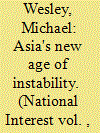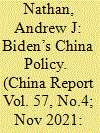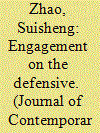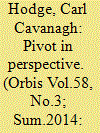| Srl | Item |
| 1 |
ID:
123649


|
|
|
| 2 |
ID:
182595


|
|
|
|
|
| Summary/Abstract |
The Biden Administration has accepted the Trump Administration’s definition of China as a ‘strategic competitor’, and has retained Trump’s tariffs, the ‘Quad’, and the upgrade in Taiwan’s protocol status. But Biden’s China policy is different from Trump’s in being truly strategic. The key elements of that strategy are focused on improving the United States’ competitiveness domestically and in international affairs; cooperation with allies and partners; an emphasis on human rights; partial decoupling of economic and technology relationships; and a search for some areas of cooperation with China. Success for the Biden strategy would consist neither of bottling up China in its current global power position nor in achieving a negotiated condominium in Asia. The Biden Administration would succeed if the United States can maintain its alliance system, keep a robust military presence in East Asia and prevent the forcible integration of Taiwan into China while avoiding major war. Several features of the China challenge make it reasonable to hope that such success is possible.
|
|
|
|
|
|
|
|
|
|
|
|
|
|
|
|
| 3 |
ID:
167324


|
|
|
|
|
| Summary/Abstract |
Facing powerful challenges from both China and the US, the long-standing engagement policy is on the defensive. Focusing on advancing American economic and security interests rather than its ideals and prioritizing reciprocity above economic cooperation, the Trump administration has declared China a strategic competitor and escalated a trade war into a multi-front conflict. However, profound interdependence continues underpinning the bilateral relationship. Neither the US nor China can afford to disengage from the other. The two countries are not natural partners but not inevitable enemies either. Competition does not mean confrontation, much less war. Engagement remains the foundation for healthy competition.
|
|
|
|
|
|
|
|
|
|
|
|
|
|
|
|
| 4 |
ID:
132556


|
|
|
|
|
| Publication |
2014.
|
| Summary/Abstract |
The article examines the reorientation of the defense policy of the United States, initiated during the Bush and Obama Administrations, toward giving increased priority to the Asia Pacific region. It begins with the historical perspective of the development of American naval power in the twentieth century. The world wars, in which Europe represented the primary theater of conflict, had the effect of shifting a greater share of American military assets toward the Euro-Atlantic theatre, while the onset of the Cold War after 1945 required the United States to develop a navy of truly global strategic reach in which Atlantic and Pacific commitments were kept in balance. With the diminished concern for European security since the end of the Cold War and the emergence of the People's Republic of China as a Strategic Competitor in the Asia Pacific region, the United States is required in an age of defense austerity to refocus attention again to the Pacific.
|
|
|
|
|
|
|
|
|
|
|
|
|
|
|
|